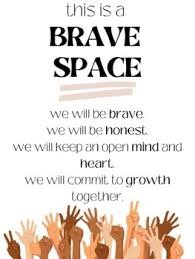In the realm of partnerships, whether in business, government or community initiatives, the language we use to define our collaborative environments profoundly impacts our outcomes.
For years, "safe space" has been the go-to term, promising havens of security and non-judgment. The term "safe space" is often used to describe a place where people can feel comfortable and free from judgment. However, the term can also be used to describe a place where people are not challenged to grow and change. But what if the pursuit of absolute safety is, paradoxically, hindering our progress? What if, instead, we need brave spaces?
The term "brave space" was coined by Brené Brown to describe a space where people can have difficult conversations and challenge each other's ideas. Brown argues that brave spaces are essential for creating a more just and equitable world. This isn't about discarding the need for respect and empathy. It's about recognizing that meaningful partnerships—the kind that drive innovation, solve complex problems, and foster deep connection—often require us to navigate discomfort, challenge assumptions, and engage in courageous conversations.
Why Brave Spaces in Partnerships?
To answer the "why brave spaces" consider this: in a world demanding constant evolution, can we afford to be afraid of unchallenged ideas because it might not feel safe? Would you agree that the most fruitful partnerships are built on honesty, even when it's hard?"
The truth is partnerships formed in exclusively "safe" spaces aren’t always the answer. They can sometimes fall prey to:
Echo chambers: Where agreement is valued over critical thinking, limiting growth and innovation.
Surface-level interactions: Where fear of offence prevents deeper, more meaningful engagement.
Missed opportunities: Where the avoidance of conflict leads to the neglect of crucial issues.
Brave spaces, on the other hand, acknowledge that:
Discomfort is a catalyst: Stepping outside our comfort zones allows us to confront our biases, expand our perspectives, and discover new solutions.
Vulnerability is strength: Sharing our authentic selves, even when it feels risky, fosters trust and deepens connection.
Growth requires friction: Constructive conflict, when managed with respect, can lead to stronger, more resilient partnerships.
What Does a Brave Space Look Like in Practice?
So, what does this look like in the real world? Imagine you're in a business partnership discussing a new strategy. A "safe space" approach might prioritize avoiding any criticism that could hurt feelings. A "brave space" approach, however, would encourage questions like: "What if our initial assumptions are wrong?" or "What are the potential downsides we're not addressing?" Here are some key elements:
"Could we agree to own our intentions and impacts?" This principle, crucial in brave spaces, emphasizes taking responsibility for what we say and how it affects others, fostering accountability.
"Are you willing to challenge by choice?" This invites partners to step in and out of challenging conversations as needed, respecting individual boundaries while encouraging engagement.
"What if we commit to controversy with civility?" This establishes a norm of respecting differing opinions, even when they clash, recognizing that disagreement doesn't have to be destructive.
How to Cultivate Brave Spaces in Your Partnerships
Building brave spaces isn't about throwing caution to the wind. It's about a deliberate, skilled approach:
Set the stage: At the outset, have an open conversation. "Would you be open to creating a space where we can be both honest and respectful, even when it's challenging?"
Establish guiding principles: Co-create norms. "Could we agree on some ground rules, such as listening actively, avoiding personal attacks, and focusing on understanding?"
Model vulnerability: Leaders and all partners should demonstrate a willingness to be open and honest. "Here's something I'm struggling with..." can be a powerful way to invite others to share.
Facilitate courageous conversations: Don't shy away from difficult topics. Use skilled considered questions: "What's the elephant in the room that we need to address?"
Reflect and adapt: Regularly assess how the space is working. "What could we do differently to make this an even braver space?"
By embracing brave spaces, we move beyond the limitations of comfort and unlock the full potential of our partnerships. We create environments where courage, vulnerability, and honest dialogue pave the way for truly transformative results.




